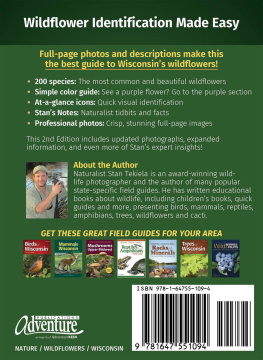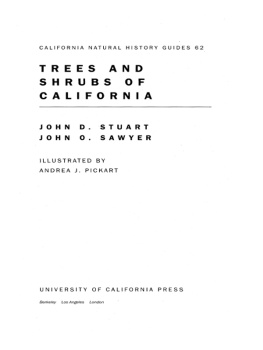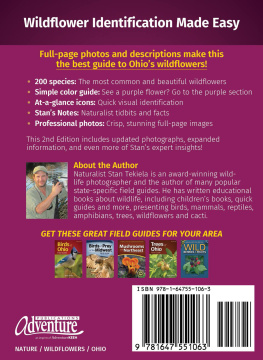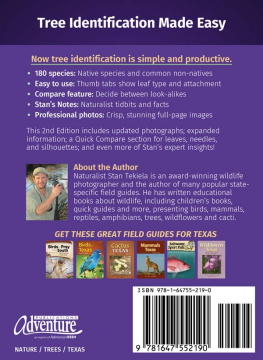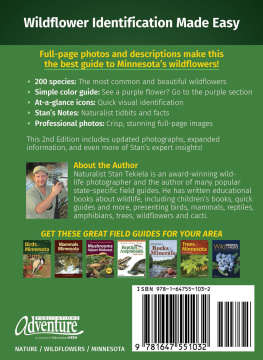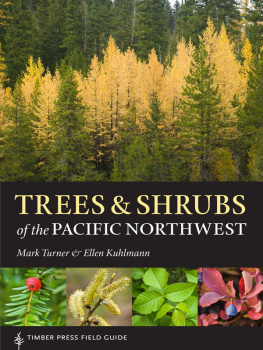
Appendix A
How to Identify Common Plant Families
One of the most valuable tools for plant identification is knowledge of the characteristics of a plant family. Here we focus on 17 of the families of trees, shrubs, and wildflowers that you are most likely to find in Texas and in many other countries of the world. As you read the characteristics, compare them with the photographs of plants from those families. With each family, we have listed some popular cultivated plants as well as wild members.
For many families, the characteristics of the genus are basically the same as those of the family, as in the genus Acer, in the maple family, Aceraceae. Refer to genus descriptions to assist you in learning about plant families.
Amaryllidaceae (Amaryllis Family)
Iridaceae (Iris Family)
Liliaceae (Lily Family)
Herbaceous plants, roots often bulbs, corms, or tuberous rhizomes; leaves alternate, also basal, usually slender, grasslike; flowers with radial symmetry or nearly so; usually with 6 colorful tepals in 2 rows (some species with 3 colorful petals, 3 green sepals).
Amaryllidaceae6 stamens, rarely 3; ovary is below base of tepals, buried in tip of flower stem (an inferior ovary). EXAMPLES: Daffodil, rain lily. NOTE: Some botanists consider the Amaryllidaceae and the Agavaceae to be part of the Liliaceae. Many species are poisonous if eaten
IridaceaeInner 3 petals may differ from outer 3 in shape and size; 3 stamens; ovary inferior; basal leaves folding in half and partially enclosing adjacent leaf. EXAMPLES: Iris, blue-eyed grass. Many species are poisonous if eaten.
Liliaceae6 stamens, rarely 3; ovary sits above base of tepals (a superior ovary). EXAMPLES: Lily, wild onion. Contains both edible and several highly toxic species.
Apiaceae (formerly Umbelliferae), Carrot Family
Herbaceous plants (rarely shrubs or trees); stems often hollow; leaves alternate, pinnately compound or highly dissected, petioles sheathing the stem; flowers minute, 5-petaled, in umbels or heads; fruit dry, 1-seeded (example: dill seed). EXAMPLES: Carrot, parsley, poison hemlock. Contains both edible and several highly toxic species.
Asclepiadaceae, Milkweed Family
Herbaceous plants or vines; sap usually milky; leaves simple, often opposite or whorled; unusual flowers with 5 petals (see Asclepias and Matelea species); flowers usually in umbels; fruit a pod, splitting open, filled with seeds usually attached to silky hairs. EXAMPLE: Milkweed. Many species toxic.
Asteraceae (formerly Compositae), Sunflower or Composite Family
Usually herbaceous plants (rarely trees, shrubs, or vines); sap milky or not; leaves simple or compound, often alternate or in basal rosettes; what may appear to be a single showy flower is actually a dense cluster (a head) of numerous tiny flowers; may have 1 or 2 types of flowers per headray flowers (petals united to form a single elongated, flattened strap) and/or disk flowers (petals form a tiny tube or funnel) (a third type of bilateral flower is rare in the family); head surrounded by numerous small leaflike bracts; fruit an achene, a 1-seeded, dry fruit (example; sunflower seed). EXAMPLES: Chrysanthemums, daisies, marigolds, asters. NOTE: This is the second largest family of flowering plants in the world. Contains many economically valuable flowers.
Brassicaceae (formerly Cruciferae), Mustard Family
Herbaceous plants; leaves usually alternate, often also in a basal rosette (basal leaves often pinnately lobed); 4 petals, not united, forming the shape of a cross (cruciform); 6 stamens, 2 usually short; fruit a silique, a many-seeded capsule characteristic of the family, quite variable in shape, either long and narrow or short and broad; after fruit splits open, only central papery segment remains. EXAMPLES: Broccoli, mustard, shepherds purse, and numerous other edible species.
Cactaceae, Cactus Family
Succulents, stems swollen, fleshy, usually green; usually lacking leaves; areoles (pits or protrusions) scattered across surface of plant; spines, when present, in clusters at areole; flowers with radial symmetry, numerous petals and stamens; fruit a many-seeded berry, often fleshy. EXAMPLE: Prickly pear. Many rare species.
Fabaceae (formerly Leguminosae), Legume or Bean Family
Trees, shrubs, wildflowers, and vines; leaves alternate, usually compound (palmate or pinnate); margins of leaflets usually entire; flowers usually with 5 petals but in 3 general forms(1) flowers papilionaceous (strongly bilateral, pea-type, with the top petal known as the banner, 2 side petals forming wings, and 2 bottom petals forming the keel (example: bluebonnets), (2) flowers only slightly bilateral, with petals almost equal in size and shape (example: sennas), (3) flowers with radial symmetry, but minute, many in a dense round head (resembling a puffball) or cylindrical spike (resembling a bottle brush) with stamens protruding and colorful (examples: huisache, mimosa tree, mesquite); fruit a bean pod, shape highly variable in different genera. NOTE: This is perhaps the third largest plant family in the world. Contains numerous economically important food plants and many species that are highly poisonous.
Lamiaceae (formerly Labiatae), Mint Family
Herbaceous plants or shrubs; stems square; leaves usually simple, opposite or whorled, often aromatic; flowers usually strongly bilateral, 5 petals united, forming 2 lips; 5 sepals, united, often bilateral; flowers either in tight cluster in the leaf axils or in spikes or whorls above leaves; 2 or 4 stamens; fruit a cluster of 4 tiny I-seeded nutlets. EXAMPLES: Peppermint, catnip, horehound. NOTE: Many mints are useful as teas, however this family is similar in appearance to Scrophulariaceae and Verbenaceae, both of which have some highly toxic species.
Malvaceae, Mallow Family
Herbaceous plants, shrubs, or rarely trees; leaves simple, alternate, often palmately lobed or veined; flowers with radial symmetry, with 5 petals; many stamens, often forming a tubular column; fruit with 5 or more segments, dry or fleshy. EXAMPLES: Hollyhocks, hibiscus, Turks cap. Many economically important species.
Orchidaceae, Orchid Family
Herbaceous wildflowers, growing in soil, tropical species often resting on trees (epiphytic, extracting water from the air); leaves simple, usually alternate, margins entire; flowers strongly bilateral, with 3 petals, 3 sepals (sometimes colorful, showy), 1 or 2 stamens. EXAMPLES: Vanilla, ladys slipper, ladies tresses. NOTE: Though orchids are rare in the U.S., the Orchidaceae is the largest family of flowering plants in the world. Many economically important species.
Ranunculaceae, Buttercup Family
Mostly herbaceous plants; leaves palmately compound, petioles sheathing the stem; flowers with radial or bilateral symmetry, often with numerous tepals, stamens, and pistils. EXAMPLES: Buttercup, anemone. Many species toxic.
Rosaceae, Rose Family
Trees, shrubs, and wildflowers; leaves simple or compound, alternate; flowers with radial symmetry, 5 petals, 5 sepals; many stamens; 1 to many pistils; fruit dry or fleshy. EXAMPLES: Rose, cherry, plum and numerous other species with edible fruit Seeds, leaves, and bark of some species contain cyanide-forming glycosides.
Scrophulariaceae, Figwort or Snapdragon Family
Mostly herbaceous plants (rarely vines, trees, or shrubs); leaves simple, alternate or opposite; flowers usually bilateral, 5 (or 4) united petals, often forming 2 lips; 4 (or 2) stamens, often with sterile 5th stamen (may be hairy); fruit a many-seeded capsule or berry. EXAMPLES: Snapdragon, penstemon. NOTE: This family is similar to Lamiaceae in appearance. Some species toxic.


